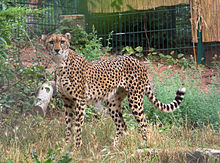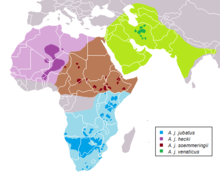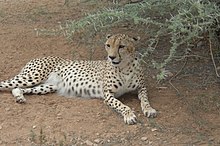
The cheetah is a large cat and the fastest land animal. It has a tawny to creamy white or pale buff fur that is marked with evenly spaced, solid black spots. The head is small and rounded, with a short snout and black tear-like facial streaks. It reaches 67–94 cm (26–37 in) at the shoulder, and the head-and-body length is between 1.1 and 1.5 m. Adults weigh between 21 and 72 kg. The cheetah is capable of running at 93 to 104 km/h ; it has evolved specialized adaptations for speed, including a light build, long thin legs and a long tail.

Acinonyx is a genus within the Felidae family. The only living species of the genus, the cheetah, lives in open grasslands of Africa and Asia.

Captive breeding, also known as captive propagation, is the process of keeping plants or animals in controlled environments, such as wildlife reserves, zoos, botanic gardens, and other conservation facilities. It is sometimes employed to help species that are being threatened by the effects of human activities such as climate change, habitat loss, fragmentation, overhunting or fishing, pollution, predation, disease, and parasitism.

The De Wildt Cheetah and Wildlife Centre, also known as Ann van Dyk Cheetah Centre is a captive breeding facility for South African cheetahs and other animals that is situated in the foothills of the Magaliesberg mountain range in the North West Province of South Africa.

The African wild ass or African wild donkey is a wild member of the horse family, Equidae. This species is thought to be the ancestor of the domestic donkey, which is sometimes placed within the same species. They live in the deserts and other arid areas of the Horn of Africa, in Eritrea, Ethiopia and Somalia. It formerly had a wider range north and west into Sudan, Egypt, and Libya. It is Critically Endangered, with about 570 existing in the wild.

The dama gazelle, also known as the addra gazelle or mhorr gazelle, is a species of gazelle. It lives in Africa, in the Sahara desert and the Sahel. A critically endangered species, it has disappeared from most of its former range due to overhunting and habitat loss, and natural populations only remain in Chad, Mali, and Niger. Its habitat includes grassland, shrubland, semi-deserts, open savanna and mountain plateaus. Its diet includes shrubs, herbs, grasses, leaves, shoots, and fruit.

The Arabian leopard is the smallest leopard subspecies. It was described in 1830 and is native to the Arabian Peninsula, where it was widely distributed in rugged hilly and montane terrain until the late 1970s. Today, the population is severely fragmented and thought to decline continuously. Previously in 2008, an estimated 45–200 individuals in three isolated subpopulations were restricted to western Saudi Arabia, Oman and Yemen. However, as of 2023, it is estimated that 100–120 in total remains, with 70-84 mature individuals, in Oman and Yemen, and it is possibly extinct in Saudi Arabia. The current population trend is suspected to be decreasing.

The East Sudanian savanna is a hot, dry, tropical savanna ecoregion of Central and East Africa.
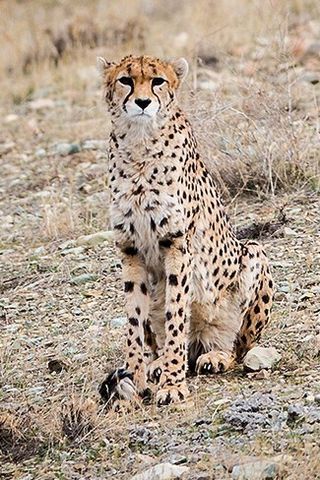
The Asiatic cheetah is a critically endangered cheetah subspecies currently only surviving in Iran. Its range once spread from the Arabian Peninsula and the Near East to the Caspian region, Transcaucasus, Kyzylkum Desert and northern South Asia, but was extirpated in these regions during the 20th century. The Asiatic cheetah diverged from the cheetah population in Africa between 32,000 and 67,000 years ago.

The Northwest African cheetah, also known as the Saharan cheetah, is a cheetah subspecies native to the Sahara and the Sahel. It is listed as Critically Endangered on the IUCN Red List. In 2008, the population was suspected to number less than 250 mature individuals.

The Cheetah Conservation Fund is a research and lobby institution in Namibia concerned with the study and sustenance of the country's cheetah population, the largest and healthiest in the world. Its Research and Education Centre is located 44 kilometres (27 mi) east of Otjiwarongo. The CCF was founded in 1990 by conservation biologist Laurie Marker who won the 2010 Tyler Prize for her efforts in Namibia.

The Somali ostrich, also known as the blue-necked ostrich, is a large flightless bird native to the Horn of Africa. It is one of two living species of ostriches, the other being the common ostrich. It was also previously considered a subspecies of the common ostrich, but was identified as a distinct species in 2014.

The Nubian wild ass is the nominate subspecies of African wild ass, and one of the ancestors of the domestic donkey, which was domesticated about 6,000 years ago. It is presumed to be extinct, though two populations potentially survive on the Caribbean island of Bonaire and in Gebel Elba.
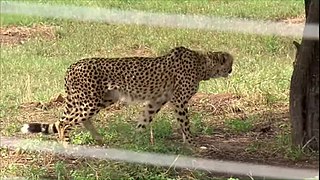
More than 70 years after India's native subspecies of the cheetah—the Asiatic cheetah —became extinct there, small numbers of Southeast African cheetah have been flown in from Namibia and South Africa to a national park in India. The experiment has been permitted by India's supreme court on a short-term basis to test long-term adaptation. The Asiatic subspecies is now found only in Iran in critically endangered numbers.

Al Ain Zoo, also "Al Ain Wildlife Park & Resort" or simply "Al Ain Wildlife Park", is a 400-hectare (990-acre) zoo located in the foothills of Jebel Hafeet in Al Ain, Abu Dhabi, the United Arab Emirates. It is primarily composed of ungulates and herbivores, such as Arabian antelopes. It also holds oryx, eland, gazelle, and lechwe, as well as the rare white lion and Nubian giraffe.
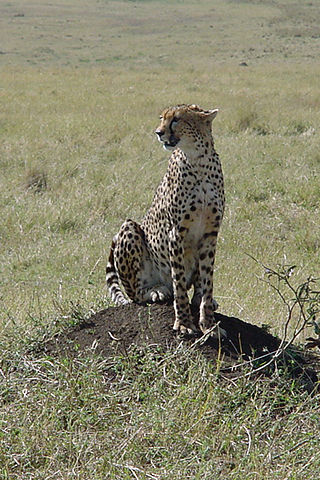
The East African cheetah, is a cheetah population in East Africa. It lives in grasslands and savannas of Tanzania, Kenya, Uganda and Somalia. The cheetah inhabits mainly the Serengeti ecosystem, including Maasai Mara, and the Tsavo landscape.

The Southeast African cheetah is the nominate cheetah subspecies native to East and Southern Africa. The Southern African cheetah lives mainly in the lowland areas and deserts of the Kalahari, the savannahs of Okavango Delta, and the grasslands of the Transvaal region in South Africa. In Namibia, cheetahs are mostly found in farmlands. In India, four cheetahs of the subspecies are living in Kuno National Park in Madhya Pradesh after having been introduced there.
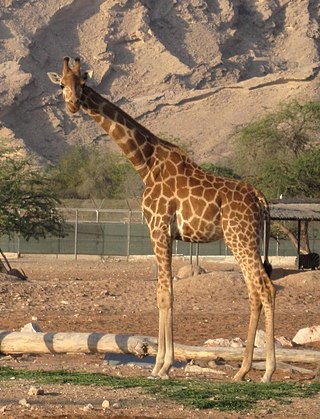
The Nubian giraffe, also known as Baringo giraffe or Ugandan giraffe, is the nominate subspecies or species of giraffe. It is found in Ethiopia, Kenya, Uganda, South Sudan and Sudan. It is currently extinct in the wild of the Democratic Republic of Congo, Egypt and Eritrea. The Nubian giraffe used to be widespread in northeast Africa. The subspecies was listed as Critically Endangered by the IUCN in 2018 for the first time due to a 95% decline in the past three decades.

The Laohu Valley Reserve (LVR) is a nature reserve located near Philippolis in the Free State and near Vanderkloof Dam in the Northern Cape of South Africa. It is a roughly 350-square-kilometre private reserve.
Laurie Marker is an American zoologist, researcher, author, educator, and one of the world's foremost cheetah experts, who founded the Cheetah Conservation Fund (CCF) in 1990. As executive director of CCF, among many endeavors, Marker helps rehabilitate cheetahs and reintroduce them to the wild, performs research into conservation, biology and ecology, educates groups around the world, and works toward a holistic approach to saving the cheetah and its ecosystems in the wild. Before her work with CCF, Marker's career started to take off at the Wildlife Safari in the U.S., where her interest with captive cheetahs began.
